Coverage on this live blog has ended. Please click here for the latest updates.
The CEO of OceanGate Expeditions, Stockton Rush, was on board and piloting the missing submersible that vanished during a mission to explore the wreckage of the Titanic, the company said Tuesday.
There is less than 40 hours of oxygen supply left on the missing vessel, named Titan, which is carrying five people, a U.S. Coast Guard official said Tuesday as the search continues.
The submersible is part of an OceanGate Expeditions tour that offers passengers a once-in-a-lifetime experience to explore the Titanic wreckage. It went missing Sunday after it lost contact with the research vessel Polar Prince.
What to know about the missing vessel, Titan
- The U.S. Coast Guard is searching for the missing research submersible, named Titan, that disappeared Sunday.
- The wreckage of the Titanic, the iconic ocean liner that sank more than a century ago, is 900 nautical miles east of Cape Cod, Massachusetts.
- The sub had up to 96 hours of oxygen supply and by 1 p.m. ET Tuesday was down to 41 hours, the U.S. Coast Guard said.
- Canadian aircraft detected “underwater noises” in the search area, the U.S. Coast Guard said early Wednesday. It said searches “yielded negative results but continue.”
- The price of a spot on the submersible was $250,000. It was on only its third trip since OceanGate Expeditions began offering trips in 2021.
British billionaire Hamish Harding, owner of Action Aviation, was also among the five people on the vessel, along with French dive expert Paul Henry Nargeolet and prominent Pakistani businessman Shahzada Dawood and his son, Suleman.
Aircraft detect 'underwater noises' in the search for missing submersible
Canadian aircraft searching for signs of the submersible detected “underwater noises” in the search area, the U.S. Coast Guard said early Wednesday.
The underwater noises, detected by Canadian P-3 aircraft, prompted searches by remotely operated vehicles, the Coast Guard tweeted shortly before 12:30 a.m. ET.
"Those ROV searches have yielded negative results but continue," the message read. "Additionally, the data from the P-3 aircraft has been shared with our U.S. Navy experts for further analysis which will be considered in future search plans."
A representative said OceanGate was unable to provide any additional information at this time.
Coast Guard image shows search patterns for Titan
The U.S. Coast Guard released an image showing the search patterns for Titan.

It said that 10,000 square miles had been searched as of Tuesday and that the searches are ongoing.
Canadian coast guard, navy and private research and commercial vessels with remotely operated vehicles have responded or were en route to help Tuesday, officials said. The U.S. and Canada also have planes searching.
Coast Guard establishes unified command in search for Titan
The U.S. Coast Guard said Tuesday night that it and other agencies and searchers are operating under a unified command as the search for the Titan continues.
More than 10,000 square miles had been searched by Tuesday morning, the Coast Guard said, and weather and visibility have improved.
Three Canadian coast guard ships, as well as a commercial vessel and a French research vessel with remote-operated vehicles, and a Canadian navy ship with a mobile decompression chamber were on the way, the Coast Guard said.
The Bahamian research vessel Deep Energy and a U.S. Air National Guard C-130 are also searching, the Coast Guard said.
Friend of man on submersible says he and Hamish Harding's family are hopeful
Titan submersible passenger Hamish Harding was excited for the voyage down to the ocean’s depths to see the wreckage of the Titanic, friend and business partner Terry Virts said Tuesday.
“He was excited. The text I got was ‘hey, we’re headed down to Titanic today, exclamation point,” Virts, a former NASA astronaut and Air Force F-16 pilot, told NBC News. Harding sent the text early Sunday.
Harding, the owner of Action Aviation, is one of five people aboard the missing Titan submersible, which is the focus of a search in the North Atlantic. He was not worried about the risks but was aware of them, Virts said.
Virts said he and Harding’s family are hopeful.
"The really good news that we have is that we haven’t heard bad news — they haven’t found a wreckage, they haven’t found debris floating, the sonar didn’t pick up any kind of crushing or exploding noise," he said. "So there’s definitely hope that the crew is alive in the submersible."
Search for missing submersible is a ‘monumental task,’ expert says
One of the best-case scenarios that might have happened to the Titan would be if it has been entangled in the wreckage of the Titanic, an ocean explorer and expert said Tuesday.
If that's the case, it could make the submersible with five people aboard easier to find, Tim Taylor, an ocean explorer and the CEO of Tiburon Subsea, said on NBC News Now.
“Lifting the submarine off the bottom is not as hard or difficult as one may think if it’s still intact,” Taylor said.
It’s unclear what happened to the submersible, and searches are ongoing.
“You’re really fighting a clock here,” Taylor said. “They don’t have a lot of options. Every hour that goes by, their options get less and less.”
Getting assets to the area takes time, he said, and when equipment arrives, searchers will have to decide where to look with the time they have.
“This is a monumental task,” he said.
Canada sending ship specializing in dive medicine
A Canadian plane with sonar flew above the area around the Titan, and Canada is sending rescue ships and a vessel equipped with a mobile hyperbaric recompression chamber, officials said.
The Royal Canadian Air Force CP-140 Aurora has been providing sonar searches, the U.S. Coast Guard said.
The Royal Canadian Navy ship HMCS Glace Bay has also been dispatched, Canada’s military said.
“HMCS Glace Bay provides a medical team specializing in dive medicine and a six person mobile hyperbaric recompression chamber,” it said in a statement.
A hyperbaric recompression chamber is used to treat or prevent decompression sickness. When divers are exposed to rapid decreases in pressure, nitrogen forms bubbles in tissue and blood.
Two other Canadian coast guard ships were either there or on the way.
U.S. Navy and Air Force sending support to search efforts
The U.S. Coast Guard is getting help in its search efforts from two other branches of the military.
A spokesperson for the Navy said it was deploying its Flyaway Deep Ocean Salvage System to assist the Coast Guard. The equipment is specifically designed for the "recovery of large, bulky, and heavy undersea objects," and it has deep ocean lifting capacity.
The Air Force will also provide aid by transporting "rescue-related" cargo from Buffalo, New York, to St. Johns, Newfoundland, it said.
King Charles asks to be updated on Titan passengers
King Charles III "has been asked to be kept up to date, and his thoughts and prayers are with the families and all those involved in the rescue operation," a royal source told NBC News.
Two of those on the submersible, Shahzada Dawood, 48, and his 19-year-old son, Suleman, are British citizens.
OceanGate CEO was piloting the sub when it disappeared
Stockton Rush, OceanGate's chief executive, was piloting the submersible, the company confirmed Tuesday.
A spokesperson previously said Rush was on board as a member of the crew.
Pilot said in lawsuit he was fired for warning Titan wasn't safe for deep dives
The pilot OceanGate hired to run manned tests of submersibles claimed five years ago in court papers that he was fired after he warned that the Titan’s carbon shell was not properly tested to make sure it could descend safely to 4,000 meters.
David Lochridge also claimed OceanGate refused to pay extra for a viewport that could be used safely at a depth of 4,000 meters.
When he complained that OceanGate would be endangering customers, Lochridge said in the court papers, he was given “10 minutes to immediately clear out his desk.”
Lochridge’s claims, which were first reported by The New Republic, were in his counterclaim to a 2018 breach of contract lawsuit OceanGate filed saying he was not an engineer. The two sides settled a few months later.
Titan's depth capabilities were downgraded short of the Titanic
The hull of the Titan vessel "showed signs of cyclic fatigue," according to a January 2020 interview with OceanGate CEO Stockton Rush, who is aboard the missing vessel. Rush told GeekWire that due to that stress, the hull rating was downgraded to a depth of 3,000 meters, 800 meters short of the Titanic's depth.
In a December 2019 slideshow that appears to have been presented to the Deep Submergence Science Committee of the University-National Oceanographic Laboratory System, OceanGate listed the depth capability of the Titan as 3,000 meters.
At the time, the CEO was announcing a new round of funding for the company, which he said would go toward funding new vessels that could go deeper than the Titan.
But in 2021, OceanGate announced that Titan, not another vessel, had completed a trip to the Titanic.
There had been no public update about Titan's depth rating since it was downgraded.
On the company’s current webpage, it says the ship is designed for a 4,000-meter depth, despite previous statements made about the vessel's capabilities.
Titan's tiny space includes some bathroom privacy
Despite the Titan's close quarters, passengers do have access to semiprivate bathroom privileges.
"But because our sub is carbon fiber and we have so much space, we actually have a bathroom that is bigger than most private jets’ (bathrooms)," OceanGate CEO Stockton Rush told German public broadcaster Deutsche Welle in 2019.
"You can put up a little curtain and you have some privacy. Most of our clients and I think even the researchers say that’s a huge thing, because nobody really looks forward to the idea of sitting next to two strangers, shoulder to shoulder, while you go to the bathroom."
Rescue operation faces extreme environment in search for missing sub
Rescuers trying to find a submersible that disappeared on a dive to the wreckage of the Titanic are not only racing the clock as the sub’s oxygen supplies dwindle — they are also battling a harsh and unforgiving environment more akin to outer space than most places on Earth.
“It’s pitch black down there. It’s freezing cold. The seabed is mud, and it’s undulating. You can’t see your hand in front of your face,” historian and Titanic expert Tim Maltin said in an interview with NBC News Now. “It’s really a bit like being an astronaut going into space.”
The deep-diving 22-foot submersible, operated by OceanGate Expeditions, vanished Sunday with five passengers on board, setting off a frantic rescue mission over a stretch of the North Atlantic Ocean roughly 400 miles off the coast of Newfoundland, Canada.
But unlike space, humanity’s presence deep in the world’s oceans is minimal, and the technology for search-and-recovery missions is limited.
OceanGate CEO called Titan's 2018 christening 'one of the great moments of submersibles'
When it was launched five years ago, the submersible Titan was hailed as a technological wonder of its time.
"This will be one of the great moments of submersibles in that this technology is what we need to explore the ocean depth," OceanGate CEO Stockton Rush said at Titan's 2018 christening in Everett, Washington.
Rush insisted that day that private industry would be the great driving force of ocean exploration with little help from government agencies.
"The days of government funding are gone," he said. "It really needs to be a private enterprise, just as exploration was at the turn of the last century where people with means make the exploration possible."
Promotional documents illustrate tight quarters
Promotional documents for the Titan craft found on OceanGate’s website reveal the tight quarters that the five passengers are currently in.
In a diagram of the manned ship, which is 22 feet by 9.2 feet by 8.3 feet according to the documents, only one of the passengers is able to fully extend their legs. The diagram calls the arrangement the "Typical seating configuration."
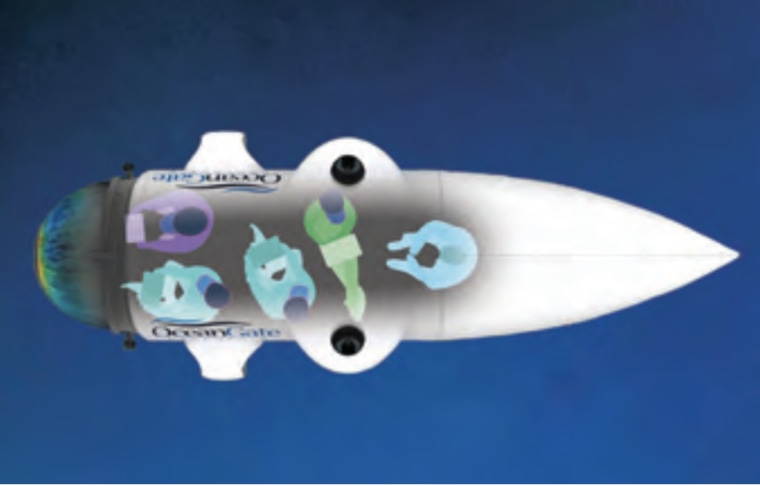
In a photograph published on a separate document, a similar configuration was depicted, with a caption saying, "Mission Specialists onboard Titan."
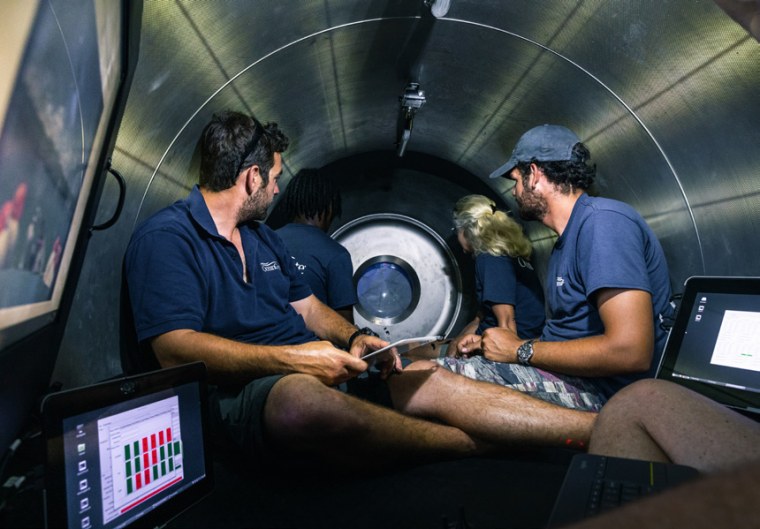
Visibility conditions have improved today for aerial search
Visibility conditions have significantly improved today for aircraft scouring the surface of the Atlantic Ocean for signs of the missing OceanGate submersible, the Coast Guard said.
“Visibility was very foggy yesterday with very little to no visibility, but was increasing today and they were expecting much better conditions from an aerial search perspective,” Chief Petty Officer Robert Simpson, with the 1st Coast Guard District Public Affairs Office, said Tuesday.
He said the weather at the scene today included 5- to 6-foot waves and 15-knot winds.
In addition to assets from the Coast Guard, Navy and Canadian partners already deployed, civilian research vessels are also volunteering to aid in the search.
OceanGate's CEO is aboard missing submersible
Stockton Rush, the CEO of OceanGate Expeditions, is aboard the missing submersible, the company confirmed Tuesday afternoon.
He is on board as a member of the crew, the company said.
So far search has yielded 'no results'
The extensive search for the missing tourist submersible near the Titanic wreck has yielded "no results," Capt. Jamie Frederick with the 1st Coast Guard District said in a briefing Tuesday.
He said so far the search has been on the surface and under the water using sonar buoys over an area the size of the state of Connecticut.
The search is ongoing with additional assets on the way to rescue the five people on board the Titan. There’s 41 hours of oxygen supply left on the vessel, "about 40 hours of breathable air," Frederick said.
France sends ship and robot to aid search for missing submersible
France is sending a ship called the Atalante to aid in the search for the missing OceanGate submersible, the French maritime ministry said Tuesday.
The ship was sent out in response to a request from American authorities Monday evening, the ministry said.
The ship, managed by the Ifremer research institute, was on a mission in the area, about a 48-hour drive from the Titanic wreckage. It'll arrive at the search site by 8 p.m. local time Wednesday.
A team from Ifremer will also arrive in Newfoundland on Wednesday morning to operate an exploration robot aboard the ship called Victor6000 that can dive to a depth of 4,000 meters.
Titan got ‘lost’ underwater last summer, CBS correspondent says
David Pogue, a CBS News correspondent, said that last year the submersible got “lost on the sea floor for a few hours,” when he was on an OceanGate expedition to visit the Titanic’s resting place.
“On my expedition last summer, they did indeed get lost for about 5 hours,” Pogue tweeted Monday. A segment on the trip aired in November.
Pogue wasn’t in the submersible, but was in a control room on a ship at the surface at the time.
He noted the submersible never lost communication with its mother ship. He said the Titan didn’t have a beacon similar to an aircraft’s emergency locator transmitter, but “such a beacon was discussed.”
“They could still send short texts to the sub, but did not know where it was. It was quiet and very tense, and they shut off the ship’s internet to prevent us from tweeting,” he said Monday. The company claimed it was to keep all channels open in case of a serious emergency, Pogue said.
Why the Titan wasn't safety classed
The missing submersible Titan wasn’t classed by an independent group that sets safety standards, as most chartered vessels are.
OceanGate said in a blog post in February 2019 that Titan wasn’t classed because its technology was so new and their innovation “falls outside of the existing industry paradigm.”
It said there’d be a “multi-year approval cycle due to a lack of pre-existing standards.”
Classing usually checks if vessels meet standards in buoyancy, number of life rafts and hull materials, the blog post said. OceanGate said that while classing has a safety value, it is “not sufficient to ensure safety.”
'No signal is very bad news,' expert says
As a sweeping effort to locate the missing submersible continued, Pengfei Liu, professor of marine hydrodynamics at Britain's Newcastle University, told NBC News that the apparent lack of signal from the vessel is “very worrying.”
Ideally, a submersible should send a signal out every few minutes, he said, but it was not known if OceanGate had detected any recent signals after research vessel Polar Prince lost contact with the sub Sunday. OceanGate did not immediately respond to a request for comment from NBC News.
“No signal is very bad news,” the marine hydrodynamics professor said. An equipment failure due to an existing defect, depleted power or external damage could cause a signal outage, he said.
“If the submersible’s hull collapses under the enormous pressure, then survival chances are zero,” he said, adding that locating it in the first place would also be complicated had the vessel gotten stuck at the wreckage, since sonar systems would need to differentiate between the two.
Missing father and son Suleman and Shahzada Dawood pictured
Shahzada Dawood and son Suleman can be seen in the photo below.
The father, a prominent Pakistani businessman, and his son were identified as being onboard the vessel by family and colleagues.

The father and son, both British citizens, belong to one of Pakistan’s most prominent families, according to The Associated Press.
Their firm invests in agriculture, industries and the health sector, while Shahzada Dawood is also on the board of trustees for the California-based SETI Institute, which searches for extraterrestrial intelligence, according to the news agency.
Submersible was operated with a video game controller
Titan, the missing tourist submersible, was operated by a video game controller and had parts that were described as “off-the-shelf components.”
During a tour of the vessel in a CBS News segment that aired in November, OceanGate Expeditions CEO Stockton Rush pointed out some of these unexpected features, including a light fixture from CamperWorld and a makeshift toilet with a plastic bottle.
He brought out a Logitech game controller, saying that “we run the whole thing with this.” It was not immediately clear whether the submersible was operated with such a controller during the latest mission.
Game controllers can have a wide range of uses, including by pilots controlling drones, as well as in medical training.
OceanGate’s website describes the five-person submersible as a combination of “ground-breaking engineering and off-the-shelf technology,” the latter of which “helped to streamline the construction, and makes it simple to operate and replace parts in the field.”
Thoughts of crew and their families driving search efforts
In the desperate search for the missing vessel touring the shipwreck of the Titanic deep in the Atlantic, crews are thinking of the lives of the five people on board first and foremost.
“The thoughts of the crew members and their families really drive our crews forward and all of the partners that have been working this complex case to make sure we can continue to find them,” Coast Guard Rear Admiral John Mauger said Tuesday morning on NBC's "TODAY" show.
Factors such as oxygen levels, intense water pressure, and the remoteness of the area make the search difficult.
The ship went down Sunday with four days worth of oxygen. The wreckage of the Titanic is also at a depth of 13,000 feet — too deep for typical U.S. Navy subs, which typically go down to 2,000 or 3,000 feet, to descend to.
Canadian aircraft dropped a sonar buoy into the ocean listening for tapping or talking in an effort to pinpoint the submersible.
OceanGate Expeditions leading underwater search
OceanGate Expeditions is leading the underwater search for the missing Titanic tourist submersible because the deep-water exploration company “know[s] that site better than anybody else,” Rear Adm. John Mauger with the Coast Guard said on NBC's “TODAY” show Tuesday morning.
As the search for the 21-foot submersible entered the third day, Mauger said search crews have an “understanding” of where the submersible was operating and searches are being prioritized in those areas.
The wreckage of the Titanic sits 900 nautical miles east of Cape Cod, Massachusetts. Searches are underway with equipment the Coast Guard has brought to the area. The agency's current focus is on getting more assets and technical experts to the scene as fast as possible.
What did the Titanic expedition set out to achieve?
The submersible that disappeared Sunday was on only its third trip since OceanGate Expeditions began offering them in 2021.
On its website, the company said the expeditions are intended to "further document the Titanic and its rate of decay."
"Given the massive scale of the wreck and the debris field, multiple missions performed over several years will be required to fully document and model the wreck site," it says. "This longitudinal survey to collect images, videos, laser, and sonar data will allow objective assessment of the rate of decay and documentation of the process."
"Qualified explorers have the opportunity to join the expedition as Mission Specialist crewmembers whose Training and Mission Support Fees underwrite the mission, the participation of the science team, and their own training," the company states.
'You just rely on the thing being well made,' past survivor says
For Roger Mallinson, one of two people rescued in the deepest underwater rescue ever, according to Guinness World Records, the search for the missing Titanic tour sub has evoked difficult memories.
Almost 50 years ago, while working on laying a transatlantic telephone cable, Mallinson's submersible hurled toward the sea floor after the rope connecting it with the mothership snapped. Mallinson’s crew of two was trapped for over 80 hours on Aug. 29, 1973, at more than 1,500 feet below sea level as rescuers scrambled to locate his sub around 150 miles off Cork, Ireland.
“You just rely on the thing being well made,” he told NBC News. As hours passed and temperatures dropped, the crew struggled to keep the carbon dioxide levels low, relying on the extra oxygen tank that Mallinson said he had snuck in before the dive.
Locating a submersible is the first challenge he said, which could be done by sonar, but he added it could be difficult to locate if the sonar is obstructed. Bringing the crew back up is another challenge. “What complicates a rescue mission is, whether they lift it from the surface or they do it from the bottom by adding buoyancy to the submersible."
Regardless, the crew inside has little options at their disposal, he said. They could be transmitting via the sea telephone but if they haven't already, "something very drastic must have happened by now," he said.
Behind the U.S. Coast Guard's search
U.S. Coast Guard officials said they have "brought all assets that we have available" to the search to find the missing sub.
Speaking at a news conference on Monday afternoon, Rear Adm. John Mauger, who is leading the search, said the Coast Guard had brought in technical experts, dropped sonar buoys to listen for underwater noise and reached out to other government agencies and private contractors for aid and “to really better understand what an undersea search and rescue effort would look like."
In addition, Coast Guard officials said they had deployed two C-130 aircraft for an aerial search and that the sonar buoys can listen to a depth of 13,000 feet. The New York National Guard is providing a third C-130, and the Canadian Coast Guard provided a C-130, as well as a P8 Poseidon aircraft that has underwater detection capabilities.
The U.S. Coast Guard said it is also relying on commercial boat operators that were already in the nearby waters, as well as OceanGate’s mother ship, Polar Prince, for help.
Mauger added at the news conference that the Coast Guard is working to expand its capabilities to include an underwater search, as well.
Sub had up to 96 hours of oxygen supply, Coast Guard says
The search to find the missing submersible has become a race against time, with Coast Guard officials saying the sub had a 96-hour oxygen "reserve capacity."
“We really brought all assets that we have available to us to bear on finding the submersible and the people in it,” Rear Adm. John Mauger said at a news conference on Monday. “When something happens on the high seas, it gets complicated quickly," he added.
On a website page for the missing vessel, Titan, OceanGate Expeditions also describes the sub as having a “life support” of 96 hours for five crew members.
Asked how much of the 96 hours were left, Mauger said on Monday that officials anticipated there were somewhere between 70 to the full 96 hours available.
Map: Where is the Titanic located?
The Titanic wreck is located around 370 miles off the coast of Newfoundland, Canada in the North Atlantic Ocean. It sits on the ocean floor in two main sections at a depth of about 12,500 feet.
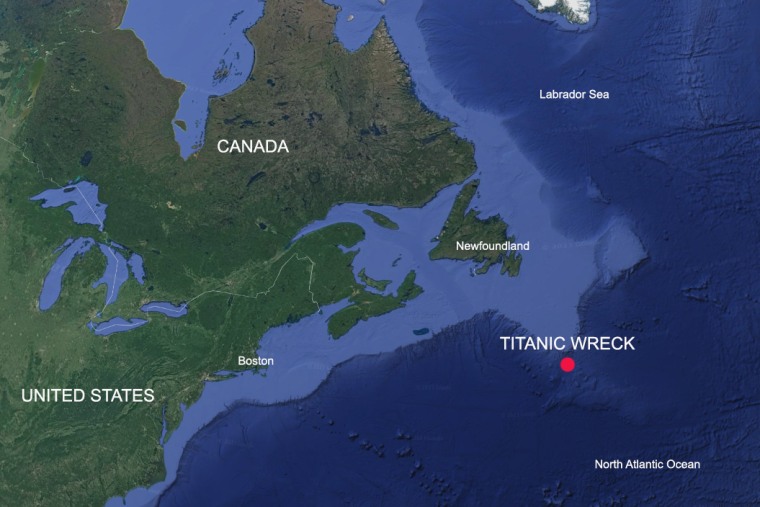
The luxury liner sank in 1912 on its maiden voyage to New York from Southampton, England after it hit an iceberg, taking the lives of over 1,500 passengers.
Since it’s discovery in 1985, the wreck has been the site of numerous expeditions, including a recent full-size digital scan, revealing the remains in never before seen detail.
The RMS Titanic Expedition Mission 5 submersible in the early hours of Sunday morning.
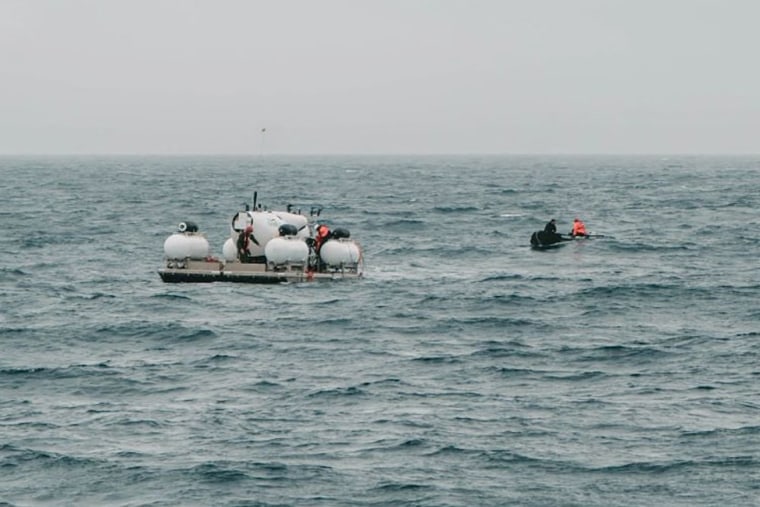
‘This could be the end’: NY writer describes trip on missing sub
Mike Reiss, a New York-based writer and producer who has worked on The Simpsons, says he was among the explorers to take a trip on the Titan sub last year.
"Yes, the sub that’s gone missing is the same one I took down to the Titanic. I wish everyone involved the best of luck," Reiss said in a Twitter post.
Speaking with BBC Breakfast in the U.K., Reiss said: “You sign a massive waiver that lists one way after another that you could die on the trip. They mention death three times on page one so it’s never far from your mind.”
“As I was getting onto the sub my thought was this could be the end," he said. “So nobody who’s in this situation was caught off guard. You all know what you are getting into."
What is a submersible?
The vessel that has gone missing is a submersible — not to be confused with a submarine.
Unlike a submarine, which is a fully autonomous craft "capable of renewing its own power and breathing air," a submersible relies on outside support, such as a surface vessel, a team onshore or sometimes even a larger submarine, according to OceanGate Expeditions, the company behind the Titanic tour dive.
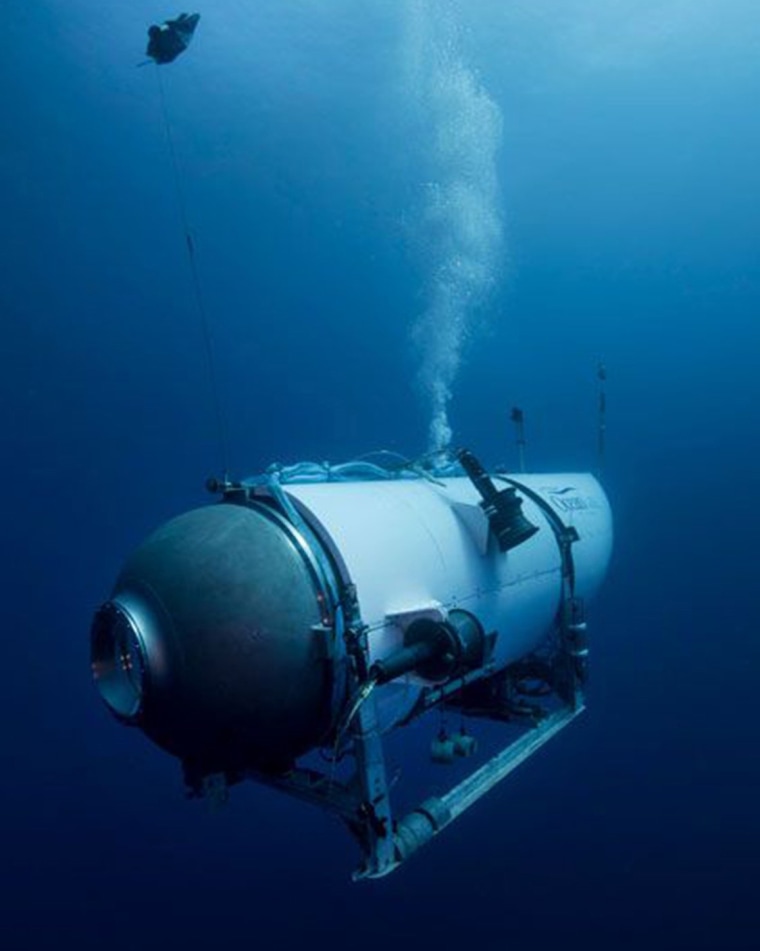
The vessel that went missing is named Titan, according to The Associated Press. NBC News was not immediately able to confirm this. On its website, OceanGate describes its Titan vessel as a "revolutionary carbon fiber and titanium submersible with a depth range of 4,000 meters (13,123 feet) that provides access to almost 50% of the world’s oceans."
"Titan ushers in a new era of crewed submersible exploration and is the only sub in the world that can take five crewmembers to these depths," it says.
Titanic tour firm offered up-close experience for $250,000
Modern in-person tourism at the Titanic is still in its infancy. The submersible that disappeared Sunday near the Titanic wreckage was on only its third trip since the company OceanGate Expeditions began offering them in 2021.
OceanGate had been promoting the third dive for months on its website and in Facebook posts, offering the chance to “follow in Jacques Cousteau’s footsteps and become an underwater explorer” — for the price of $250,000.
“Become one of the few to see the Titanic with your own eyes,” the tour company said on its website. The ticket comes with a title: “mission specialist.”
Participants have included a chef, an actor, a videographer and someone who worked in banking, the company said on Facebook. One of the customers said on Instagram last year that it was a once-in-a-lifetime experience that lived up to her expectations.
First full-size scan showed Titanic wreck as never seen before
Few people will ever get the opportunity to survey the wreckage of the Titanic up close — a bid that was at the heart of Sunday's mission when the Titan vessel went missing.
The first first full-size digital scan of the Titanic recently revealed the world’s most famous shipwreck as never seen before, however, and experts are hopeful it will provide more insight into how the liner came to sink in 1912.

What we know about missing billionaire Hamish Harding
Hamish Harding, a billionaire and the owner and chairman of Action Aviation, is among the five people onboard the missing vessel.
Action Aviation, established in 2004, is described on its website as a global sales company in business aviation.
A post Sunday on Harding’s Instagram account said he was joining OceanGate’s expedition “as a mission specialist” — typically a one-time crew member who pays a fee to join the effort.
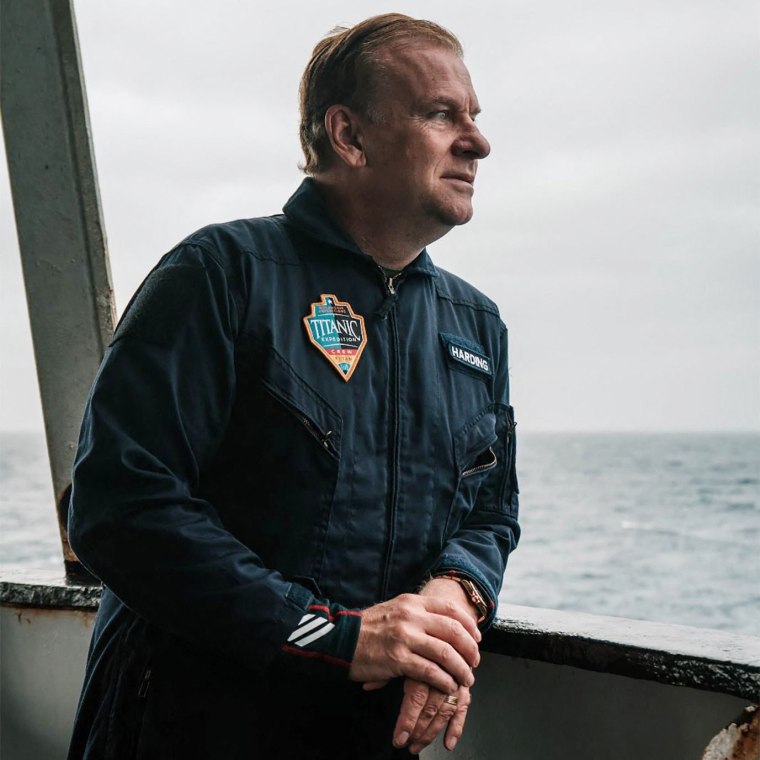
"Due to the worst winter in Newfoundland in 40 years, this mission is likely to be the first and only manned mission to the Titanic in 2023," Harding said in his post. He said that a "weather window" had just opened up and that the team was going to attempt a dive the following day.
"Until then we have a lot of preparations and briefings to do," he said.
Pakistani businessman and son were onboard sub, family says
A prominent Pakistani businessman, Shahzada Dawood and his son, Suleman, were among the five people onboard the vessel when it went missing, family and colleagues said.
“We are very grateful for the concern being shown by our colleagues and friends and would like to request everyone to pray for their safety,” the family said in a statement provided by Engro, a company where Dawood serves as vice chairman of the board.
"We, at Engro, remain in prayer for their swift and safe return, and will share any updates we may have as and when they come," the company said.
Hamish Harding, the billionaire owner and chairman of Action Aviation, was previously identified as one of the missing crew members. The other two people who were onboard the vessel have yet to be identified.
Search continues for missing Titanic tour submersible
The U.S. Coast Guard continues its search on Tuesday for the missing submersible that disappeared Sunday after it departed for a mission to explore the wreck of the Titanic.
The 21-foot submersible and its five-person crew started a dive Sunday morning from the Canadian research vessel Polar Prince, the Coast Guard said. But the Polar Prince lost contact with the vessel after an hour and 45 minutes and it remains missing.
The missing submersible — named Titan, according to The Associated Press — is part of a tour offered by private company OceanGate Expeditions exploring the Titanic wreckage, 900 nautical miles east of Cape Cod, Massachusetts.










